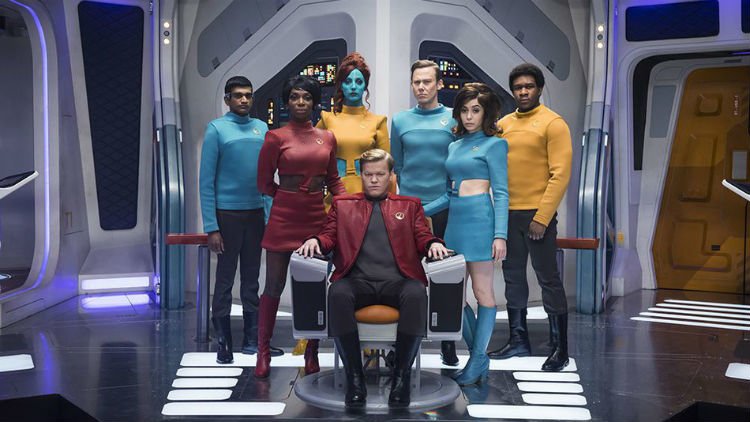
‘Black Mirror’ has produced several episodes that have resonated with fans. None as much as the ‘USS Callister.’ Fans praise the episode for its spectacular cinematography from Emmy-nominated director of photography, Stephan Pehrsson. Pehrsson previously worked on shows like ‘The Moorside,’ ‘You, Me, And The Apocalypse,’ and ‘X Company.’ He recently sat down for an interview to explain how the ‘U.S.S. Callister’ came to life. Here are some of the highlights:
So if you were thinking of shooting the opening sequence a little differently, what was the original idea for that?
In the script, the star captain comes through the door, and it sort of reminded us of the first ‘Star Trek’ that J.J. Abrams did, and that’s where we were headed. We were going to shoot it Steadicam, move around, have sun flares coming in. [Laughs] And it just didn’t seem like J.J. Abrams! His lines are really cool, and our lines were super cheesy! It just didn’t fit. And we were so worried about making something that looked silly, but then we realized that being silly will make it work better. It was just about finding our confidence that it would be the right thing for the show to do.
Yeah, this really captured the cheesiness of whenever a starship would hit an asteroid or something, and the ship would shake, but it’s just the actors pretending to be jostled…
[Laughs] When the whole ship shakes, we sort of shake the camera a bit, and then all the actors would shake, apart from the captain. The captain is just standing. He’s not feeling the vibration at all. So those sort of subtle inconsistencies, because William Shatner wouldn’t move when things got crazy, you know? That kind of stuff.
I love the sequence where Nanette wakes up in the medical bay. How did you approach that?
I love that one, too. We have that whole montage leading up to it. Everything is getting more intense. You’re tracking all of the characters. You’re tracking the loading bar, which is telling you how much it’s assimilated. You’re seeing their faces. And then you have that sort of black hole, and the editors kept that dark as long as possible, to the point where people might start checking their computer, “Is this still on?” [Laughs] And then she comes back on, and it’s a new world, and a new character, sort of, so we have to change perspective.
So we go close-up, and then develop out, as she discovers this new world. We get to experience the world through her eyes. It was something we story-boarded very graphically, and it was one of the earliest sequences we did. The first thing Toby told me when I came on board was that they had decided to use a different medical bay.
They had a different room for it, a different structure. It was like a medical bay you might have seen in Aliens, like a square room with a bed in the middle of it, with a little bit of technical stuff in it. And he said, “No, no, no. I want a circular room, with circular lights.” He had a very clear idea about that. And it developed from there. It was like a birth of light, and then out she goes, to explore the spaceship.
How did you approach shooting their away missions on other planets? One had a red sand desert environment, and the other had a black rock beach…
In the original script, the first planet was more like an ‘Indiana Jones’ action cave, and then they ended up in a gladiator arena where this monster turned up. And the other planet was supposed to be a jungle planet, with a beautiful beach or waterfall in the middle of it. But we were limited to where we could go. Where could we go that we could afford, where it would be warm in February? When you’re in Europe, that’s the Canary Islands.
We went to Lanzarote, which is a volcanic island, which fit that sort 1960s style of shooting. And we were going to shoot in a quarry which had red sand, but we ended up in a crater structure instead, and it wasn’t red enough. So we brought in red sad from the quarry and put it all over the ground to make it extra red. The beach was at a lake, and it was all black sand, which made it look alien and different. It looked more original.
On our last day, we shot the scene with Jesse [Plemons] and Cristin [Milioti] on the beach, when she goes in the water. And even though it was a warm place, it was still February. The water was only 10 degrees. So we could only have a limited amount of time in the water, and the sun was going down as well, so the main challenge was just getting everything in that we wanted to do with it. The main challenge was time.
Did anything change from your initial storyboard concepts?
When one of the characters turns into a monster, how we were going to see the legs sprout out of her back, and what angles we’d see the tentacles in the foreground. We used some of those shots, but the blocking didn’t work out exactly how it was on the storyboards, so we had to adapt how we shot it. By the way, did you notice Jesse’s wife [Kirsten Dunst] in the episode?
What? No!
[Chuckles] It’s a nice little Easter egg. When the coffee is being handed out in the office scene, she walks past. When we were shooting it, she turned up on set, and Jesse asked her, “Do you want to be in it?” And she was like, “Uh, yeah!” So she’s in the background. It’s brilliant.
